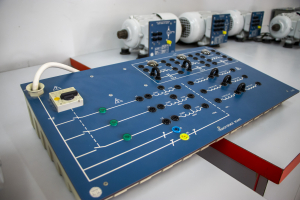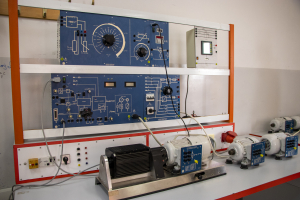The Electrical Machines Laboratory was established in 1978 and is affiliated with the Department of Electrical Engineering. The new Electrical Machines Laboratory was equipped with all the means of protection needed by any laboratory, as 3 main operating units were built, equipped on tables that were designed similar to the tables found in driving and industrial automation laboratories.
The competencies and skills required in an electrical machines’ lab can vary depending on the specific focus and level of the lab (e.g., undergraduate, graduate, research). However, here are some common competencies and skills that are often expected in an electrical machines’ lab setting:
Understanding of Electrical Machines:
Knowledge of various types of electrical machines, such as DC machines, induction machines, synchronous machines, and transformers.
Understanding the operating principles, characteristics, and applications of different electrical machines.
Lab Safety:
Adherence to safety protocols and procedures in the lab environment.
Knowledge of emergency procedures and proper use of safety equipment.
Instrumentation and Measurement:
Proficiency in using electrical measurement instruments such as multimeters, oscilloscopes, power analyzers, and other relevant devices.
Ability to make accurate measurements of electrical parameters in machines.
Circuit Analysis:
Competence in analyzing electrical circuits related to machine operation.
Understanding of circuit components, connections, and the impact on machine performance.
Troubleshooting:
Ability to identify and troubleshoot issues in electrical machines and associated circuits.
Skill in diagnosing and rectifying faults in machines.
Experimental Design and Execution:
Capability to design and set up experiments related to electrical machines.
Proficiency in executing experiments, collecting data, and analyzing results.
Data Analysis:
Skill in processing and analyzing experimental data using statistical and graphical tools.
Ability to interpret results and draw conclusions from experimental data.
Documentation and Reporting:
Ability to maintain accurate records of experiments and observations.
Proficiency in preparing formal lab reports and documentation.
Teamwork and Communication:
Collaboration skills for working effectively in a team.
Clear and concise communication of findings and results.
These competencies and skills are foundational for success in an electrical machines lab and provide a well-rounded set of abilities for individuals working in this field.
There are many specializations that can be studied in this laboratory:
- College of Engineering:
- Industrial Automation Engineering.
- Biomedical Devices Engineering.
- Electrical Power and Technology Engineering.
- Communications and Electronics Engineering.
- Intelligent Systems and Devices Engineering.
- Mechatronics Engineering.
- Electronics and computer control.
- Electrical engineering and renewable energy.
- Industrial Automation.
- Intelligent systems in buildings.
- Electric and Hybrid Vehicles.
- Sustainable manufacturing engineering.
- Auto Electrical.
- Electrical Machines (I) (5589).
- Electrical Machines (II) (5594).
- Electrical Machines and Drive Systems (8243).
- Electrical Machines (3151).
- Electrical Machines and Transformers (2366).
- Electrical Machine I (2022).
- Electrical Machine II (2038).
1- Control Unit for braking machine.
2- Universal power supply, DC (Fixed 200V- 4A, and Variable 0-250V- 6.5A), AC (Fixed 3-phases 380V L-L.
3- Single phase Autotransformer.
4- Plain Compound DC machine.
5- Series DC machine.
6- 3-Phase Induction Machine.
7- 3-Phase Synchronous Machine.
8- 1-ph, 3-ph Transformer.
9- Synchronizing Panel of synchronous generator.
10- Universal Power meters.
11- Multimeter and Wattmeter.
12- Contactors, Overload, Pushbutton, Selector, and Reversal switch, Y-∆ Switch, circuit breaker switch.
Ensuring occupational health and safety in an electrical machines lab is crucial to prevent accidents and protect the well-being of individuals working in the environment. Here are some general occupational health and safety instructions for an electrical machines lab. Please note that these are guidelines, and specific rules and regulations may vary depending on your location and the nature of the lab. Always consult with local safety authorities and follow the guidelines of your institution.
- Personal Protective Equipment (PPE):
- Wear appropriate PPE, including safety glasses, gloves, and any other required protective gear.
- Ensure that all PPE is in good condition and used properly.
- Lab Access and Entry:
- Only authorized personnel should have access to the electrical machines lab.
- Keep the lab entry/exit points clear and easily accessible.
- Emergency Procedures:
- Familiarize yourself with emergency exits, evacuation routes, and the location of emergency equipment (fire extinguishers, first aid kits, etc.).
- Know the emergency shutdown procedures for all equipment in the lab.
- Equipment Operation:
- Before operating any electrical machines, ensure that you have received proper training.
- Follow the manufacturer's guidelines and operating procedures.
- Do not operate equipment if you are unsure about its condition or if it appears to be malfunctioning.
- Never override safety features or remove safety guards.
- Electrical Safety:
- Keep work areas dry, and do not use electrical equipment with wet hands.
- Use equipment with grounded plugs, and inspect cords for damage before use.
- Avoid overloading electrical outlets and circuits.
- Machine Maintenance:
- Regularly inspect and maintain electrical machines according to the manufacturer's recommendations.
- Report any malfunction or damage immediately to the responsible personnel.
- Workspace Organization:
- Keep work areas clean and organized to minimize tripping hazards.
- Store tools and equipment in designated areas when not in use.
- Training and Education:
- Ensure that all personnel working in the electrical machines lab have received adequate training on safety procedures and equipment operation.
- Communication:
- Clearly communicate with other lab members about ongoing experiments, potential hazards, and safety concerns.
- First Aid:
- Know the location of first aid kits and emergency response procedures.
- Report any injuries, accidents, or near misses promptly.
- Safety Signage:
- Clearly mark hazardous areas and equipment with appropriate safety signage.
- Supervision:
- Ensure that a qualified supervisor is present or available when conducting experiments, especially for less experienced personnel.
Eng. Bahaa Mohammad Alwohoush.


